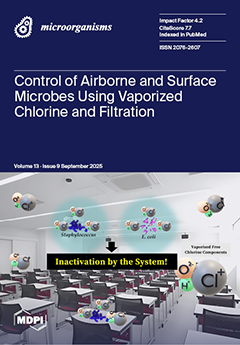Avian chlamydiosis, primarily caused by
Chlamydia psittaci (
C. psittaci), poses significant threats to poultry and avian trade. Emerging species such as
Chlamydia gallinacea (
C. gallinacea),
Chlamydia avium (
C. avium), and
Chlamydia ibidis (
C. ibidis) have recently been detected in birds. However, the prevalence and genetic diversity of avian chlamydia in birds within Guangxi remain unknown. In this study, 1744 samples collected from apparently healthy birds were screened, revealing an overall positivity rate of 28.20% (95% CI, 27.58–28.90%, 492/1744) for avian chlamydia. Among poultry, pigeons had the highest positivity rate at 62.30% (95% CI, 55.37–68.69%, 152/244), followed by chickens at 25.05% (95% CI, 21.25–29.23%, 128/511), geese at 18.12% (95% CI, 12.93–24.82%, 29/160), and ducks at 14.14% (95% CI, 11.57–17.26%, 82/580). Additionally, pet and wild birds exhibited positivity rates of 40.35% (95% CI, 34.20–46.83%, 92/228) and 42.86% (95% CI, 24.52–61.83%, 9/21), respectively. Phylogenetic analysis based on the outer-membrane protein A gene indicated that chicken samples belonged to genotypes B of
C. psittaci and
C. gallinacea. In ducks, genotypes A and B of
C. psittaci and
C. gallinacea were identified, representing the first documented occurrence of
C. psittaci genotypes B and
C. gallinacea in ducks in China. The nucleotide sequences from goose samples were initially clustered into genotype A group, while those from pigeons were clustered within genotype B. Furthermore, positive samples from pet birds were classified into genotypes A and B, as well as the
C. gallinacea group. Similarly, samples from wild birds were classified into genotypes A and B. These findings suggest that diverse avian chlamydia genotypes are circulating among bird populations in Guangxi, with an expanding host range indicating potential cross-species transmission. Moreover, certain strains derived from waterfowl were found to cluster with those linked to recent psittacosis outbreaks, highlighting the zoonotic potential of avian chlamydia. Therefore, sustained surveillance for avian chlamydia in bird populations and monitoring its genetic evolutionary characteristics are essential to decrease public health risks.
Full article






